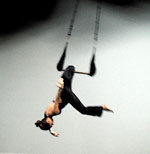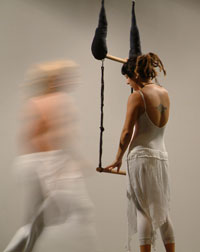Watch an
interview
with Robert Davidson the choreographer.
Dancers fly through the air to laud mystic
Friday, 3 October 1997
By Gene Armstrong
THE ARIZONA DAILY STAR
Now it becomes clear, this fascination with trapezes,
and with the work of Seattle choreographer, dancer and aerialist Robert
Davidson. Tucson's Orts Theatre of Dance has exhibited such a
fascination for the past three years, which may have seemed puzzling,
though certainly pleasant, for local dance audiences. But with this
weekend's presentations of the full-length version of Davidson's
``Airborne: Meister Eckhart'' - continuing Saturday and Sunday at the
Pima Community College Center for the Arts - the arcs and spins of his
fixed-point trapezes make elegant sense.
The trapezes allow the choreographer and the other
dancers to simulate the illusion of becoming closer to God. They are a
metaphor for grace, which by the definition of 13th century Christian
mystic Johannes Eckhart - the subject of the piece - is the
manifestation of God through the good actions of mankind. And a more apt
metaphor would be difficult to find. As the shaved-headed and beatific
Davidson portrays Eckhart, he swoops across the stage, feet inches from
the floor, as an angel in a Renaissance painting.
Indeed, the trapeze is a simple but stunning device,
allowing dancers to seem frozen and static in midair, yet moving across
a field. When five (or, in some instances, 10) dancers float through the
air, their trapezes varying slightly from formation in natural
variations, the effect is mesmerizing. O-T-O presented an excerpt from this
work a year ago.
At yesterday morning's preview performance,
``Airborne: Meister Eckhart'' featured a passionate and well-rehearsed
cast of almost 40 people, including members of the O-T-O troupe, the
Desert Voices choir, guest dancers and gentle-voice narrator Patrick S.
Cunningham. Choral music written by Davidson and based on Eckhart's work
make up the bulk of the music, although Chuck Koesters and James Knapp
contributed an electronic score. Though deeply spiritual, Eckhart's
ideas were in opposition to the teachings of the medieval church,
earning him the label heretic. He espoused a Zen-like philosophy that found
God in everyday occurrences and opposed the popular asceticism of
the time.
Fanaticism is represented by the ``Dance of the
Inclusae,'' a startling trio piece. These women locked themselves in
tiny chambers, torturing themselves closer to divinity. Beth Baumann is
magnetic as the Lost Inclusae who seeks out Eckhart's teachings later in
the work. Clearly, Eckhart's message, as well as Davidson's,
emphasizes the spirituality inherent in all natural things and in
community, as is illustrated by the glowing group dances of ``In Umbra
Chant and Spiral'' and ``Dance of the Faithful.''
Both spectacle and art, ``Airborne: Meister Eckhart'' is
the most absorbing work of modern dance seen in Tucson in several years.
Back to top
Watch an interview
with Robert Davidson the choreographer. |


